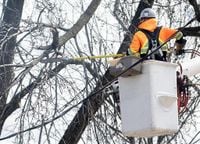The district of Muskoka has declared a state of emergency as a severe ice storm wreaks havoc across the region. The announcement came late on March 31, 2025, following prolonged freezing rain that has disrupted access to vital power grids and roads. Residents are now urged to stay home and avoid travel due to numerous blocked roads, fallen trees, and hazardous live power lines.
Authorities are taking the situation seriously, advising the public to maintain a safe distance of at least 10 meters from any downed power lines. In addition, they recommend using flashlights instead of candles to minimize fire risks, and suggest that electric vehicle owners unplug their cars to prevent surges and potential damage.
As the storm progresses, Environment Canada has issued warnings for various regions, forecasting significant ice accumulation. In Quebec, travel conditions are expected to deteriorate with freezing rain complicating journeys across the province. Accumulations of freezing rain ranging from 2 to 15 millimeters are anticipated, particularly affecting the south and southwest regions, including Estrie, Montreal, and Montérégie.
Environment Canada has warned that surfaces like roads, sidewalks, and parking lots may become icy and slippery, leading to dangerous conditions. "The freezing rain could break tree branches, causing further hazards," the agency stated in a special bulletin released on March 30, 2025. This advisory is particularly crucial for those in the greater Montreal area, as well as Outaouais, Estrie, Lanaudière, Mauricie, and Laurentides, where ice accumulation could reach up to 15 millimeters.
The weather system is expected to move through central Quebec, with regions like Bas-Saint-Laurent, Gaspésie, Saguenay-Lac-Saint-Jean, and Côte-Nord facing 2 to 5 millimeters of freezing rain on March 31, 2025. Snow is also in the forecast for Abitibi-Témiscamingue, where residents could see 20 to 30 centimeters of accumulation.
In Ontario, the situation is dire as well, with over 200,000 customers experiencing power outages due to the same weather system. Hydro One reported that ice accumulation on tree branches has caused many to break, resulting in downed power lines. By Sunday morning, March 30, 2025, approximately 225,000 customers were still without power, although Hydro One had managed to restore service to over 100,000 customers over the weekend.
Hydro One spokesperson Caroline Des Rosiers explained, "The outages are linked to the weather system, with freezing rain and strong gusts weakening vegetation that comes into contact with the power grid." The Montérégie region was particularly hard-hit, with 6,700 customers without power, primarily in the Vaudreuil-Soulanges and Haut-Richelieu areas.
Despite the severity of the storm in Ontario, Quebec has seen less severe consequences. Urgences-santé reported no significant increase in sidewalk falls, and the Québec 511 service showed no rise in road accidents compared to normal. However, authorities continue to urge caution as intermittent precipitation is expected to continue into Monday, March 31, 2025, with heavy showers forecasted in Montreal.
As the storm progresses, residents across affected regions are advised to remain vigilant. The Ministry of Transport has deployed teams to apply de-icing agents to ensure road safety, but drivers are reminded to exercise caution, especially those who have already removed their winter tires. Sarah Bensadoun, a spokesperson for the Ministry, emphasized the importance of maintaining a safe distance from other vehicles and reducing speed to adapt to the slippery conditions.
As the freezing rain warnings extend into northeastern and southern Ontario, the potential for localized flooding looms as temperatures rise. Areas that were hardest hit on Saturday, March 29, 2025, may see flooding as the ice melts. This includes Barrie, where tens of thousands are still without power.
New Brunswick is also under freezing rain warnings, with the possibility of snow turning to freezing rain overnight as a warm front approaches late Monday morning, March 31, 2025. The warning extends to Prince County, Prince Edward Island, where freezing rain could last up to four hours and result in five millimeters of ice accumulation.
The current weather system has been closely monitored since March 24, 2025, and has shown unpredictable changes over the past few days. Hydro-Québec assures that its teams are rapidly deployed to respond to the ongoing situation. Des Rosiers concluded, "This is a system we are watching very closely, and it will continue to evolve as conditions change."
As residents brace for further impacts from this severe weather, the focus remains on safety and preparedness. The community is urged to stay informed and heed warnings from local authorities as conditions continue to develop.
![[Couverture en direct] Verglas : plusieurs écoles seront fermées lundi en Ontario](https://thumbor.evrimagaci.org/spaZ5fBcso6qq6vYUzRShikgDaM=/200x0/tpg%2Fsources%2Fdf2e51d6-2abb-43a2-aacd-564689d327f5.jpeg)







